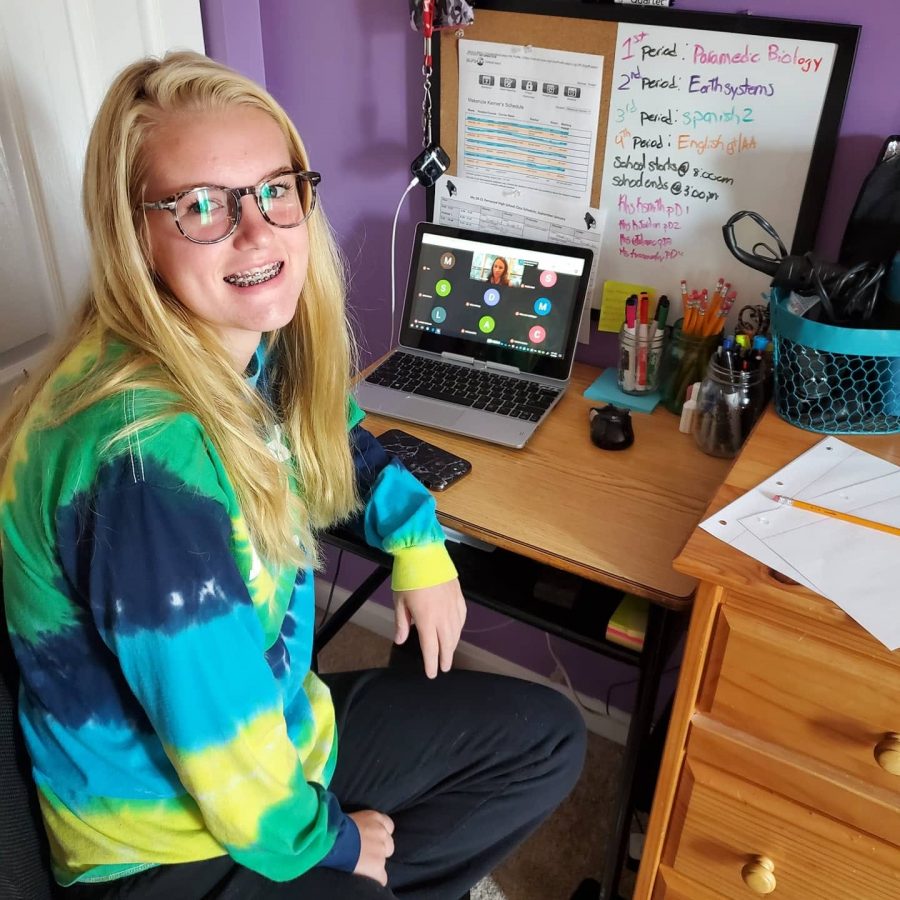Virtual Learning Program as an Option for Next School Year, But Should it be a Permanent Option as Education Moves Forward
May 17, 2021
Due to COVID-19, virtual learning has been in place for over a year now. As it evolved and progressed over the past fourteen months, students grew into two different experiences. Some found it draining and hard to stay motivated, while others found the flexibility helpful and manageable. Concerned with those struggling in the virtual environment, hybrid learning moved into place between March and April of this 20-21 school year.
Students and families were given the option to return in-person for two days a week or continue with full time virtual learning. With the virus still out there and children under the age of 16, but now 12, unable to get vaccinated yet, and some students benefitting and preferring virtual learning to in person, it raised the question on whether students would have virtual learning as a permanent option as we move out of the pandemic.
Earlier this month BCPS announced it would offer a full time five days a week virtual learning option for students. As of mid-May, a number of families across the county selected the fully virtual option. The Virtual Learning Program as BCPS is calling it will be organized into zones with a high school, middle school, and elementary program for each of BCPS’s five zones. Students though will be co-enrolled in their assigned zoned school so they can participate in sports and events at their assigned school.
However, though students can select the full time virtual option and still participate in sports and activities at their home school there is concern about how and if they’ll have access to select magnet or elective courses that are typically available in their home schools. Kenwood Principal Powell shares, “There’s some things that may cause hurdles for students that may wish to stay virtual moving into next school year. Such as, and this isn’t necessarily for sure, but are they able to participate in every course they wish such as electives, magnet courses, courses towards graduation requirements? So, there are a lot of logistical items that are still being talked through and looking at different options there. But those are potentially some questions that would need to be answered prior to any decision being made.”
Students and families are happy to see the choice to choose virtual or in person as an option for next school year. Several Kenwood High students were happy to see it remain as a choice. For some students it’s about time management, managing their social anxiety, or simply just doing better virtually which can all be factors in if a student chooses whether or not to do school virtually next school year.
Junior Eliza Brown, though an in-person student herself, believes that virtual learning should remain as a permanent option for the future of education, “There are less distractions at home for some. At home you can have your own space with your own set-up of how you want to work and what is better for you to concentrate to complete work. Learning from home can also help kids who have social anxiety or are introverts.”
Junior Daja Lane believes otherwise though. “I feel schools should not make virtual learning a permanent option. Everyone cannot learn virtually and some just select it as a way to avoid school. Those who want to learn at home should try homeschooling.” This difference in opinion is also something adults and students are grappling with as education moves towards a post pandemic world. There is much discussion on how education will be permanently changed as a result of the pandemic and its reliance on virtual learning, but it will still be some time before we really know how different it will be.
Throughout this past year staff have experienced a wide variety of teaching practices as they’ve had to adjust to virtual teaching. Just as some students have loved it and some have hated it, so have the teachers and staff. Staff too can apply to teach fully virtual from a designated BCPS location next year if they’d prefer over in person teaching. Mr. Powell adds, “If anything, we’ve learned over the past year, we’ve learned that- or really solidified that all of our students have different learning preferences and do well in certain environments. We solidified that that some students really need that in person instruction, but we’ve also have learned that we have some students, and not just in Kenwood but across the county, that have thrived in the virtual environment. So, as we always continue thinking about student choice and student options for learning, this is also another scenario that may come from this pandemic that we have and can provide options for students to be in a virtual setting and also students to be in an in person setting, but most likely in two different capacities.”
Now that we know virtual learning is an option for next school year, the next thing some are wondering is if it’ll become a permanent option. This will be something that will be discussed and decided in the future by Baltimore County Public Schools. Mr. Powell could see the benefits of virtual learning remaining an option for students in the post pandemic world of education. He shares, “There is a large amount of students across Baltimore county that have been very successful in the virtual environment. As they have been so successful with that, I think there is a lot of communication and discussions that families have had around having this be an option for students moving forward. I do think that for us, I’m excited to be able to have students be back in the building every day, five days a week, and transitioning back to what may be a new normal. But I think, there is a lot of discussion and input from families across Baltimore county that have been successful in the virtual learning environment and want to advocate for that to be an option moving forward. It comes down to students and families having some options to select from moving forward.”
Differentiation and choice has been a focus of education for some time but the possibility of virtual learning as a permanent option for the future adds more choice for students and families. Students that have different preferences in learning besides in person should be heard during this crucial time of transitioning after the pandemic.
Though it is unclear yet how virtual learning will fully look for next school year and beyond, the discussion of virtual learning is really just beginning rather than ending as we near the end of this pandemic.

